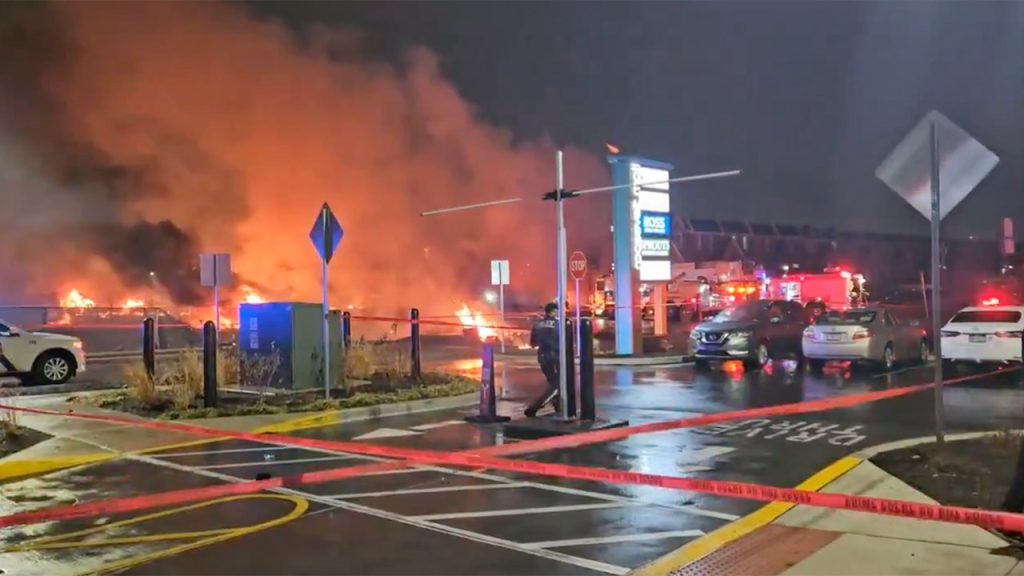On Friday evening, a Learjet 55 private aircraft crashed onto a street near Roosevelt Mall in Northeast Philadelphia, Pennsylvania, triggering a significant emergency response. The incident, which occurred around 6:30 p.m., involved a plane that had departed from Northeast Philadelphia Airport and was destined for Springfield-Branson National Airport in Missouri. The impact resulted in multiple house and vehicle fires in the vicinity of the 2900 block of Cottman Avenue. Initial reports indicate two individuals were on board the aircraft, with the exact number and extent of injuries on the ground remaining unclear as of the immediate aftermath. The crash prompted a rapid response from local authorities, with road closures implemented around the affected area, including sections of Roosevelt Boulevard. The City of Philadelphia issued a public alert via social media, categorizing the event as a “major incident” and advising residents to avoid the area.
The dramatic nature of the crash was captured in a video circulating online, depicting the aircraft’s descent followed by a bright flash upon impact. The explosive force of the crash ignited multiple fires, engulfing nearby houses and vehicles. Emergency crews promptly arrived at the scene to combat the flames and assess the damage. Simultaneously, high-ranking officials acknowledged the gravity of the situation. Pennsylvania Governor Josh Shapiro confirmed communication with Philadelphia Mayor Cherelle L. Parker, pledging the full support and resources of the Commonwealth to assist in the response. U.S. Department of Transportation Secretary Sean Duffy, also monitoring the situation, announced his intention to visit the Federal Aviation Administration (FAA) headquarters to gather more detailed information.
The investigation into the crash has been delegated to the National Transportation Safety Board (NTSB), with the FAA providing support. The incident follows closely on the heels of a separate aviation tragedy, where an American Airlines passenger plane collided mid-air with an Army Black Hawk helicopter near Reagan National Airport, resulting in the loss of 67 lives. This recent crash adds further complexity to the ongoing examination of aviation safety protocols and procedures. Preliminary information suggests potential challenges with staffing at the Reagan National Airport air traffic control tower on the night of the helicopter collision, highlighting potential vulnerabilities within the air traffic management system.
The Learjet crash near Roosevelt Mall underlines the vulnerability of urban areas to aviation accidents, particularly those involving smaller aircraft operating in close proximity to residential and commercial zones. The rapid response of emergency services and the coordination between local, state, and federal agencies were crucial in containing the damage and initiating the investigative process. The NTSB’s investigation will aim to determine the cause of the crash, considering factors such as mechanical failure, pilot error, weather conditions, and air traffic control procedures. The findings will be critical in informing future safety measures and preventing similar incidents.
This event also underscores the importance of effective communication during emergency situations. The City of Philadelphia’s prompt use of social media to alert residents and advise avoidance of the affected area played a crucial role in managing the immediate aftermath. The communication between Governor Shapiro, Mayor Parker, and federal officials demonstrates the collaborative approach required in responding to such critical incidents. The willingness of Secretary Duffy to directly engage with the FAA highlights the urgency and seriousness with which the government is addressing aviation safety concerns.
The convergence of two significant aviation incidents within a short timeframe underscores the need for a thorough review of existing regulations and protocols. The NTSB’s investigations into both the Learjet crash and the helicopter collision will be instrumental in identifying systemic issues and recommending improvements. The outcomes of these investigations could have far-reaching implications for the aviation industry, influencing training procedures, air traffic control operations, and aircraft maintenance standards. The tragedies serve as stark reminders of the inherent risks associated with air travel and the constant need for vigilance in ensuring safety and preventing further loss of life. The focus on determining the root causes of these incidents and implementing effective preventative measures will be paramount in restoring public confidence and enhancing the safety of the aviation system.

